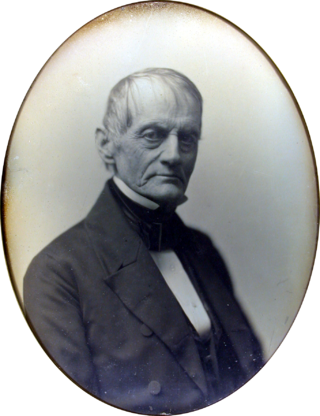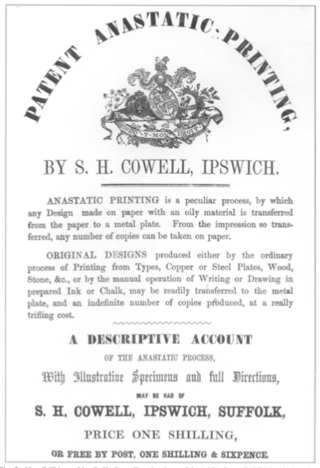
Samuel Coleridge-Taylor was a British composer and conductor. Of mixed-race descent, Coleridge-Taylor achieved such success that he was referred to by white musicians in New York City as the "African Mahler" when he had three tours of the United States in the early 1900s. He was particularly known for his three cantatas on the epic 1855 poem The Song of Hiawatha by American Henry Wadsworth Longfellow. Coleridge-Taylor premiered the first section in 1898, when he was 23. He married an Englishwoman, Jessie Walmisley, and both their children had musical careers. Their son, Hiawatha, adapted his father's music for a variety of performances. Their daughter, Avril Coleridge-Taylor, became a composer-conductor.

Edward Byles Cowell, was a noted translator of Persian poetry and the first professor of Sanskrit at Cambridge University.

Gerrard Street is a street in the West End of London, in the Chinatown area.

William Appleton was an American businessman and politician from Massachusetts. He was a trader, shipowner, and banker, and served as a U.S. representative from Massachusetts from 1851 to 1855, and again from 1861 to 1862.

Samuel Appleton was an American merchant and philanthropist, active in New Hampshire, Massachusetts, and Great Britain.
Lieutenant General Sir Henry James was a Royal Engineers officer who served as the director-general of the Ordnance Survey, the British Government mapping agency, from 1854 to 1875. Sir Henry was described by the agency itself as "perhaps Ordnance Survey's most eccentric and egotistical Director General". Sir Henry spent most of his life working for the Ordnance Survey and after becoming its head he introduced the new science of photography. He also would later claim to be the inventor of the process known as Photozincography or Zinco. Sir Henry also played a part in the resolving of the battle of the scales.

Charles Graves was an Irish mathematician, academic, and clergyman. He was Erasmus Smith's Professor of Mathematics at Trinity College Dublin (1843–1862), and was president of the Royal Irish Academy (1861–1866). He served as dean of the Chapel Royal at Dublin Castle, and later as Bishop of Limerick, Ardfert and Aghadoe. He was the brother of both the jurist and mathematician John Graves, and the writer and clergyman Robert Perceval Graves.

Samuel Waldo was an American merchant, land speculator, army officer and politician in the Province of Massachusetts Bay.
Cowell is an English language surname.

Sir Saul Samuel, 1st Baronet was an Australian colonial merchant, member of parliament, pastoralist, and prominent Jew. Samuel achieved many breakthroughs for Jews in the colonial community of New South Wales including the first Jew to become a magistrate, the first Jew elected to parliament, the first Jew to become a minister of the Crown.
John Lewis (1912–1996) was a Welsh typographer, printer, illustrator and collector of printed ephemera.
Nathaniel Bland was Archdeacon of Aghadoe from 1861 until his death on 25 February 1885. A graduate of Trinity College, Dublin, he held curacies at Templenoe and Kilcrohane. He was the incumbent at Knockane from 1851 to 1861; and then of Aghadoe until 1875.
Rev. John William Hewett (1824-1886) was an English "enthusiastic Anglo-Catholic of extreme views", an educationalist, hymnist, and antiquary.
W.S. Cowell Ltd was a British printing company that produced a variety of books, including popular children's literature of the 1930s and prestigious coffee table books. Established in 1818, the company played a significant role in the history of printing in Ipswich. The company developed the Plastocowell printing process. However after a number of mergers in the late twentieth century, the name was finally dropped by its corporate owners in 1988.

The history of printing in Ipswich, Suffolk dates back to the sixteenth century. The oldest extant book published in Ipswich is an edition of Historia Evangelica by Juvencus published in 1534. However this book was printed in Antwerp. In 1547 and 1548, there was a sudden increase in printing in Ipswich. For many years it was thought that this was the work of three printers, but more recent research has indicated there were but two, the third being a false imprint for books printed in continental Europe.

Bibliography of early American publishers and printers is a selection of books, journals and other publications devoted to these topics covering their careers and other activities before, during and after the American Revolution. Various works that are not primarily devoted to those topics, but whose content devotes itself to them in significant measure, are sometimes included here also. Works about Benjamin Franklin, a famous printer and publisher, among other things, are too numerous to list in this bibliography, can be found at Bibliography of Benjamin Franklin, and are generally not included here unless they are intensely devoted to Franklin's printing career. Single accounts of printers and publishers that occur in encyclopedia articles are not included here.

Anastatic lithography is a method of printing developed by 1840 in Erfurt. The technique provided a means for facsimile reproduction, which was developed and promoted by Werner and William Siemens. Whereas the reproduction of the four pages of the 25th September 1841 issue of The Athenaeum, a London scientific and literary journal, was so true to the original that it caused concerns expressed in an article "Printing and Piracy–New Discovery" which was published in the issue No. 736 published December 4, 1841.

Rudolph Appel was German printer and business man who played a major role in the development of anastatic lithography, a brand name that referred to already existing transfer lithography processes, and Photozincography in United Kingdom in the mid-nineteenth century.












